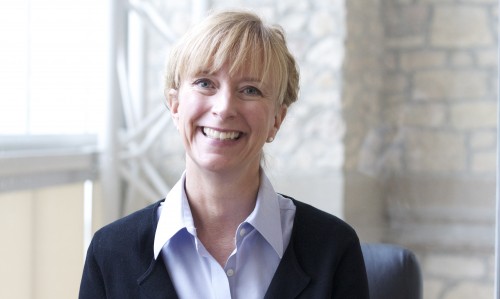Clear teaching and learning priorities
Leaving St. Thomas More (STM) after 14 years, even just to relocate to the Administration Building a few hundred metres away, broke Patti McDougall’s heart.
By Kris Foster That, explained the new vice-provost of teaching and learning, is the price for a dream job that "allows me to marry together so many parts of my background."
That, explained the new vice-provost of teaching and learning, is the price for a dream job that "allows me to marry together so many parts of my background."
No doubt that McDougall's administrative experience at STM as assistant, associate and interim dean, will be put to the test as she oversees the University Learning Centre, the Centre for Continuing and Distance Education, and eMAP in addition to being a champion of academic programming innovation.
But as important to the teaching and learning portfolio, McDougall explained, is her research background as a developmental and educational psychologist.
"One of my interests has been in student experience. For example, following students as they transition from high school into university and asking what factors are involved in whether things go well or whether there are many challenges. This background lends itself to this portfolio and is a wonderful opportunity to continue to develop administrative skills that match those passions."
While only on the job since the start of January, McDougall has a pretty clear idea of what the next couple of years will look like. "In the next year or two, what is important are the areas where we can accomplish a lot. IP3 (third integrated plan) gives us pretty clear direction on where we need to be going."
McDougall highlighted four main areas that will be front and centre moving forward: experiential learning, academic Aboriginal initiatives, distributed learning, and the scholarship of teaching and learning.
"We will increase the number of experiential learning opportunities on campus by 10 per cent by 2016," she said. "Part of that is getting an accurate assessment of what those opportunities are right now. I suspect a lot of this is already happening but not recognized."
The same applies to academic Aboriginal initiatives on campus, explained McDougall. "We've made progress on an inventory of what we do on campus, but we also want to look at how these activities can be co-ordinated so that we can find synergies and meaningful ways for collaboration (between groups)."
The goals around distributed learning are straightforward, though getting there may not be, she said. "We are going to establish a few programs where students can complete an entire degree learning where they live. Across campus we have a lot of capacity and expertise. So again, we want to bring all of this together."
As for the scholarship of teaching and learning, how teaching and scholarly work can be linked, McDougall thinks, like others, that "research inspires teaching and teaching inspires research. If you want to increase activity you have to show its value and also support it. In the case of scholarship of teaching and learning we want to integrate this work into the academic culture on campus. Part of that work will involve appropriately recognizing its value through tenure, promotion and merit."
These areas all come back to the students, she continued, one of the reasons she decided to accept the position. "I thought about whether I would have the chance to be involved with students. I wouldn't be here if I didn't think I could have a direct impact on the student experience."
Better supporting students and their experiences, is what McDougall hopes to accomplish. "Students come here for many different reasons and with many different aspirations. We work to be attuned to those dreams and needs."
Success will be "getting stakeholders, faculty and students, engaged and excited about initiatives. We need to spark interest and share our passion," said McDougall, whose excitement and passion when talking about these issues is obvious. "A lot of people probably think this, but I do believe that I have one of the best jobs on campus."

